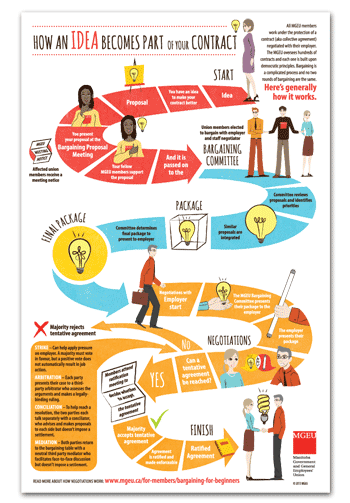How Bargaining Works
All MGEU members work under the protection of a contract (aka collective agreement) negotiated with their employer. In fact, the MGEU oversees hundreds of contracts, covering more than 1,000 job classifications.These contracts are usually effective for three or four years and cover a wide range of work-related concerns, including wages, hours of work, benefits, overtime, and safety and health.
The terms of the contract are negotiated between:
- an MGEU Bargaining Committee – made up of union members who’ve been elected by fellow members to speak on their behalf, along with a professional union negotiator; and
- management representatives of the employer.
The bargaining process begins at Local meetings where MGEU members elect their negotiating representatives. Those elected to the Committee are responsible for organizing a series of meetings to collect bargaining proposals. Members must fill out the Bargaining Proposal Form (Civil Service members fill out a different Civil Service Bargaining Proposal Form) to bring to a meeting, where it is voted on by other members. The process provides every member with the opportunity to share what they’d like to see in the contract, or suggest improvements to what currently exists.
A Give-and-Take Process
Based on the feedback at Local meetings, the committee pulls together a package of proposals to take to the bargaining table on behalf of the members.
The employer also comes to the table with changes they’d like to make to the contract.
The negotiating process, which can last anywhere from a few weeks to several months, usually involves a kind of give-and-take, with the union Committee working at all times to gain and/or maintain as much as possible for its members.
Staying in-the-loop during negotiations
At key times in negotiations, your Committee may email important Bargaining Updates to members when there is important news to share. It is important to keep your contact information with the union up-to-date to ensure you receive these emails. For groups who are currently at the bargaining table, we also post the latest bargaining news and an overview of bargaining so far.

